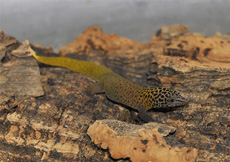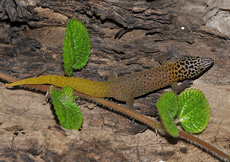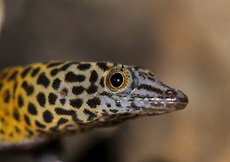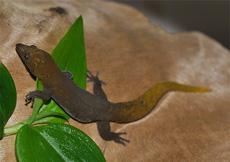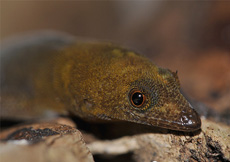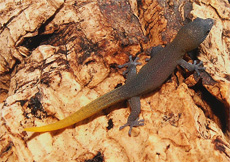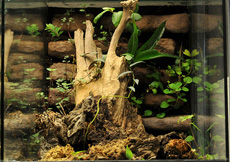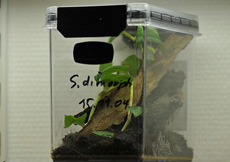Sphaerodactylus dimorphicus
(FONG & DÍAZ, 2004)
Distribution:
This species is only known in the Cuban province of Santiago.
Description:
Sphaerodactylus dimorphicus is around 6.5-7 centimeters in size, it is a major representative of this genus. In this species there is a very strong sexual dimorphism. The rump, tail and legs of the males are yellow and sometimes the body can also be dyed bright orange. Their head is gray with rounded dark brown to black spots, each spot is larger than the ear opening. Running from the eyes to the nostrils are narrow brownish bands. The females are simple in coloration, the torso and the legs are light gray-brown in color. Their head and tail are pale yellow-brown. In both sexes the underside is gray and in males the underside will have yellow edges. Hatchlings are charcoal gray, the base of the tail is gray and yellow, the tail tip is lemon yellow. This coloration is lost after a few weeks and the juveniles then strongly resemble the females.
Habitat:
In nature this species is found in semi-moist to wet areas. Whether these areas are developed building sites or closed off forests, seems of secondary importance to them. They are found in wall crevices under loose bark and other suitable hiding places. They never climb far up and are always found at elevations below one meter.
Husbandry and Breeding:
A breeding pair can be kept in a terrarium measuring 30x50x40 centimeters. A depth of 50 centimeters is important because they feel safer and this enables you to watch them fairly well. The back and side walls can be decorated with various materials such as rough bark, natural cork or synthetic stones stacked together, with the latter taking care to fill the gaps with coconut humus or similar material. You can plant the terrarium with Tradescantia, Peperomia, small bromeliads, Ficus pumila and other small plants. A few pieces of bark, a little piece of Japanese knotweed (Fallopia japonica) and beech foliage complete the setup. Water for the animals is provided by a daily spraying, in addition the funnels of bromeliads will ensure water is always available. A small water bowl and a bowl of crushed up cuttlefish bone are a must in completing the setup.
Light may be provided by a small compact lamp or fluorescent T8 lamp rated for daylight color. Spot lamps are not used by the animals, but you can use these to help increase the temperature. The illumination period will vary depending on the season. In summer it is 12 hours, in winter only 9 hours. The terrarium temperature ranges between 25-28°C (77-82°F) in summer and in winter it is lowered to around 22-25°C (72-77°F).
They can be fed with micro crickets, fruit flies, firebrats, small Buffalo worms, woodlice and various meadow plankton. Occasionally they will even capture a housefly if one is offered to them.
Females begin laying eggs when the length of day and temperature increases significantly. As usual with all Sphaerodactylus it is a single egg. This egg is always well hidden, and there seems to be no fixed sites, one time it will be buried, the next you will find in a gap someplace at the back of the tank and sometimes under a piece of bark on the ground. The eggs are very hard to find in the terrarium and because the adults are very fast you will have limited opportunities to work in the terrarium, so most juveniles hatch in my terrarium, the adults do not bother the young. In an incubator the young animals hatch out between 60-80 days at a constant temperature of 28°C (82°F). The young measure around 30 millimeters long upon hatching and for this species it is also quite handsome. The young can be raised in converted 1.7 liter household containers. This is not a problem when provided with good food. Prey in the form of small crickets, fruitflies, firebrats, aphids, springtails or other small white isopods may be provided. The animals need a good supply of vitamins for their well being. At the age of one year the animals are sexually mature. Previous breeding results have shown them to be female heavy. All in all it is not a very complicated specimen, however they are very quick and for this reason we can not recommend them to a novice in this field.
